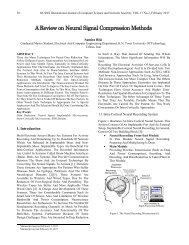New Computer Architectures and their Applications
IJNCAA_Vol6No1
IJNCAA_Vol6No1
You also want an ePaper? Increase the reach of your titles
YUMPU automatically turns print PDFs into web optimized ePapers that Google loves.
International Journal of <strong>New</strong> <strong>Computer</strong> <strong>Architectures</strong> <strong>and</strong> <strong>their</strong> <strong>Applications</strong> (IJNCAA) 6(1): 1-8<br />
The Society of Digital Information <strong>and</strong> Wireless Communications, 2016 ISSN 2220-9085 (Online); ISSN 2412-3587 (Print)<br />
on both performance <strong>and</strong> energy usage. However,<br />
there is lack of exclusive parameter selection<br />
strategy for energy management in order to<br />
balance between system performance <strong>and</strong> energy<br />
consumption. In Table I, we summarized the<br />
selection of performance metrics <strong>and</strong> system<br />
behaviors that used in those existing scheduling<br />
approaches to design energy model.<br />
Table 1. Relationship between Scheduling Rule <strong>and</strong><br />
Energy Model<br />
No. Scheduling Rule Energy Model<br />
1 Heuristic approach<br />
used for prescheduling<br />
processing.<br />
Such predictable rule<br />
satisfies energy saving<br />
where it consumed<br />
less processing time.<br />
2 Threshold for<br />
processor, memory,<br />
disk<br />
<strong>and</strong><br />
communication link in<br />
resource allocation.<br />
If the threshold chosen<br />
is too low it might<br />
reduces resource<br />
utilization while<br />
setting too high<br />
threshold leads to<br />
communication<br />
bottleneck.<br />
3 Migrating or<br />
remapping strategy in<br />
scheduling using a set<br />
of virtual machines<br />
(VMs).<br />
It considers<br />
busy <strong>and</strong> idle<br />
states of<br />
processing<br />
elements.<br />
It considers<br />
resource<br />
utilization <strong>and</strong><br />
overhead in the<br />
system.<br />
Virtualization<br />
leads to energy<br />
efficiency.<br />
3. Classification of Scheduling Parameters<br />
The existing scheduling approaches (e.g.,[3, 4,<br />
7, 20]) analyzed the performance of <strong>their</strong> energy<br />
management system through various scheduling<br />
algorithms. They have chosen several types of<br />
parameters such as time-based perspective,<br />
utilization <strong>and</strong> overhead.<br />
3.1. Time-based Metrics<br />
Time-based metric is one of the most popular<br />
parameters that chosen for focusing green Cloud.<br />
Such parameter used to measure the effectiveness<br />
of scheduling decision for uncertain, dynamic <strong>and</strong><br />
large-scale environment. The time-based metrics,<br />
for example, execution time, waiting time <strong>and</strong><br />
response time is designed to monitor <strong>and</strong> manage<br />
queuing problems in scheduling. The major<br />
problem in scheduling is to allocate various users’<br />
jobs to be mapped <strong>and</strong> executed by the right<br />
resources. Due to the scheduler needs to get<br />
information from users <strong>and</strong> resources, the<br />
scheduling decisions are most of the time<br />
consumed more processing energy compared than<br />
storage. The resources need to be available to<br />
perform the job execution at most of the time.<br />
Therefore, in order to improve the execution time<br />
for minimizing energy consumption we need to<br />
take into account the optimization technique in<br />
designing scheduling approach.<br />
Furthermore, the issue on suitable queue length<br />
comes into a picture when the total waiting time of<br />
jobs leads for high energy consumption. Note that<br />
the determination of queue size is significantly<br />
related to the scale of computing system.<br />
Specifically, the queue size contributes for better<br />
job waiting time that it relates to buffer<br />
management. The suitable size of queue needs to<br />
be identified to reduce data access time in the<br />
buffer. We do not want to power the entire<br />
memory module in lengthy time only for data<br />
accessing operation. Hence, the effective<br />
scheduling approach for dynamic environment<br />
required to define the (most) suitable queue length<br />
for reducing power consumption.<br />
3.2 Utilization<br />
There are scheduling approaches that calculate<br />
the energy consumption based on computing<br />
resources’ busy <strong>and</strong> idle states. In particular, the<br />
resources that have high busy time means the<br />
system utilization is improved. Meanwhile the<br />
system is considered has low utilization when<br />
there are many resources that idle in a given<br />
observation time. However, from energy<br />
management perspective, high utilization may<br />
leads to large energy consumption. The resource<br />
that has high utilization certainly consumed high<br />
processing energy in order to complete the task<br />
execution. It is more crucial in the idle state of<br />
resources. There is huge percentage of power<br />
consumption (i.e., for electricity <strong>and</strong> cooling<br />
systems) to facilitate the running resources. The<br />
idle resources need to be available even though<br />
there is no processing happen in <strong>their</strong> space.<br />
Resource utilization only 53% of total energy<br />
3






